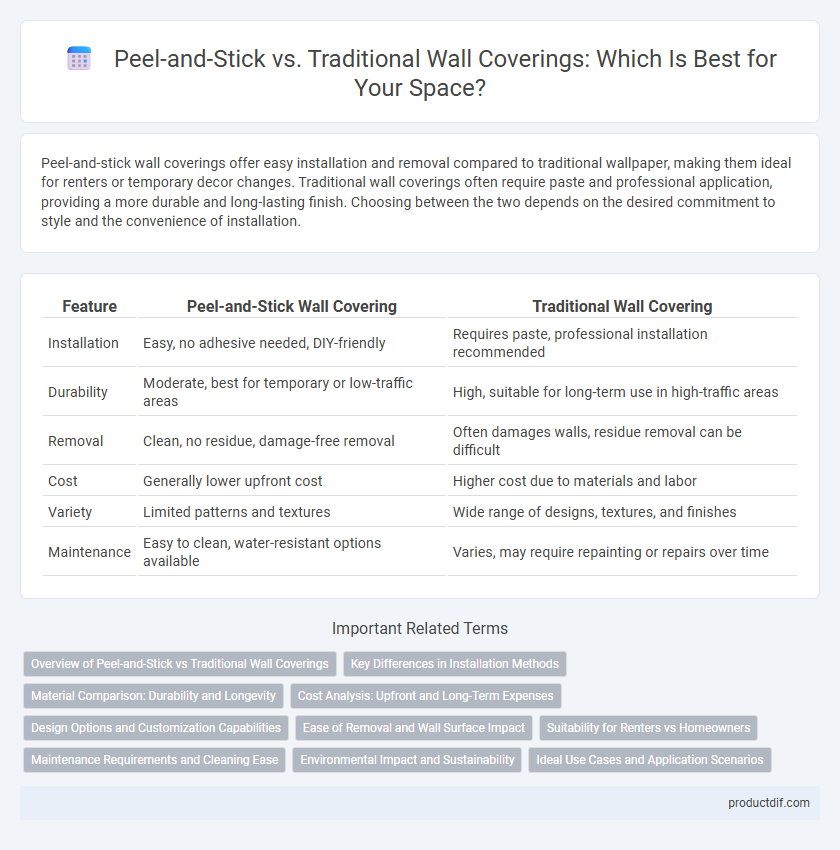Peel-and-stick wall coverings offer easy installation and removal compared to traditional wallpaper, making them ideal for renters or temporary decor changes. Traditional wall coverings often require paste and professional application, providing a more durable and long-lasting finish. Choosing between the two depends on the desired commitment to style and the convenience of installation.
Table of Comparison
| Feature | Peel-and-Stick Wall Covering | Traditional Wall Covering |
|---|---|---|
| Installation | Easy, no adhesive needed, DIY-friendly | Requires paste, professional installation recommended |
| Durability | Moderate, best for temporary or low-traffic areas | High, suitable for long-term use in high-traffic areas |
| Removal | Clean, no residue, damage-free removal | Often damages walls, residue removal can be difficult |
| Cost | Generally lower upfront cost | Higher cost due to materials and labor |
| Variety | Limited patterns and textures | Wide range of designs, textures, and finishes |
| Maintenance | Easy to clean, water-resistant options available | Varies, may require repainting or repairs over time |
Overview of Peel-and-Stick vs Traditional Wall Coverings
Peel-and-stick wall coverings provide a convenient, mess-free installation process with adhesive backing that eliminates the need for paste or water, offering quick application and easy removal. Traditional wall coverings typically require paste, professional installation, and tools, making the process more time-consuming and permanent. While peel-and-stick options excel in DIY flexibility and temporary decor solutions, traditional wallpapers offer greater durability and a wider variety of intricate designs.
Key Differences in Installation Methods
Peel-and-stick wall coverings offer a simple, adhesive backing that allows for quick, tool-free installation, making them ideal for renters or DIY projects. Traditional wall coverings require paste application with brushes or rollers and proper surface preparation, demanding more time and skill for alignment and smoothing. The peel-and-stick method minimizes mess and drying time, whereas traditional wallpaper ensures stronger durability and a seamless finish with expert installation.
Material Comparison: Durability and Longevity
Peel-and-stick wall coverings, often made from vinyl or fabric-backed materials, provide moderate durability suitable for temporary or low-traffic areas but may show wear and peeling over time. Traditional wall coverings, typically composed of woven fabrics, heavy-duty vinyl, or embossed paper, offer superior longevity and resistance to damage, making them ideal for high-traffic or long-term installations. The durability of traditional materials ensures they maintain appearance and structural integrity longer than most peel-and-stick options, which tend to be more vulnerable to environmental factors like humidity and temperature fluctuations.
Cost Analysis: Upfront and Long-Term Expenses
Peel-and-stick wall coverings typically have a lower upfront cost, ranging from $1 to $7 per square foot, compared to traditional wallpaper that can cost between $2 and $10 per square foot including adhesive and labor. Long-term expenses favor peel-and-stick options due to easier removal and minimal damage, reducing potential repair and repainting costs, whereas traditional wallpaper often requires professional installation and costly wall preparation. Maintenance costs for peel-and-stick coverings remain low as they are generally water-resistant and straightforward to clean, unlike traditional wallpaper which may need specialized cleaning and more frequent replacements.
Design Options and Customization Capabilities
Peel-and-stick wall coverings offer an extensive range of design options including bold patterns, textures, and finishes that can be easily changed or updated, making them ideal for renters or temporary spaces. Traditional wall coverings provide deeper customization through durable materials like vinyl or fabric-backed paper, allowing for intricate designs, embossing, and paintability that enhance long-term aesthetic appeal. Both options support personalized interior styles, but peel-and-stick excels in flexibility and easy application, while traditional coverings deliver superior texture variety and lasting durability.
Ease of Removal and Wall Surface Impact
Peel-and-stick wall coverings offer superior ease of removal compared to traditional wallpaper, often peeling away cleanly without the need for harsh chemicals or extensive scraping. This method significantly reduces the risk of damage to wall surfaces, preserving paint and drywall integrity, whereas traditional wallpaper removal can strip paint and require wall repairs. The low-impact, user-friendly nature of peel-and-stick options makes them ideal for renters and temporary design updates.
Suitability for Renters vs Homeowners
Peel-and-stick wall coverings offer renters an ideal solution due to their easy installation and removal without damage, preserving security deposits. Traditional wallpaper suits homeowners seeking long-term durability and a more permanent aesthetic transformation. Renters benefit from the flexibility of peel-and-stick options, while homeowners prioritize traditional wallpaper for lasting style and investment.
Maintenance Requirements and Cleaning Ease
Peel-and-stick wall coverings offer superior maintenance ease, requiring only gentle wiping with a damp cloth to remove dirt and stains without damaging the surface. Traditional wallpaper often demands careful cleaning with specific solutions or professional treatment to avoid deterioration or discoloration over time. The self-adhesive nature of peel-and-stick products also allows for quick removal and replacement, reducing long-term upkeep efforts compared to conventional wallpaper.
Environmental Impact and Sustainability
Peel-and-stick wall coverings often use vinyl-based materials that can release harmful VOCs and are challenging to recycle, contributing to landfill waste, whereas traditional wallpaper made from paper or natural fibers tends to have a lower environmental footprint and can be more biodegradable. Traditional wallpapers, especially those sourced from FSC-certified paper, offer better sustainability through renewable materials and reduced chemical treatments. Selecting low-VOC adhesives and wallpapers with eco-label certifications enhances indoor air quality and supports environmentally responsible choices in wall covering applications.
Ideal Use Cases and Application Scenarios
Peel-and-stick wall coverings excel in temporary or rental spaces due to their easy removal and minimal surface damage, making them ideal for DIY projects and quick updates. Traditional wallpapers are better suited for permanent home renovations or commercial spaces requiring durable, long-lasting finishes and complex patterns. Peel-and-stick options are preferred for smooth, clean surfaces, while traditional wallpapers perform well on textured walls and accommodate more intricate installation techniques.
Peel-and-stick vs Traditional Infographic

 productdif.com
productdif.com